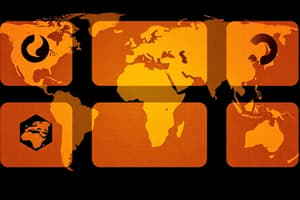Podcast
Questions and Answers
What is a major obstacle to achieving transparency and accountability globally?
What is a major obstacle to achieving transparency and accountability globally?
- Organized crime
- Weak institutions
- Corruption (correct)
- Lack of resources
What is a key challenge to local governance and justice?
What is a key challenge to local governance and justice?
- Inequality and discrimination
- Limited access to justice
- Weak institutions
- All of the above (correct)
What is the main goal of the peace agreement between the Colombian government and the FARC?
What is the main goal of the peace agreement between the Colombian government and the FARC?
- To end the conflict (correct)
- To promote social inclusion
- To reduce poverty
- To address the root causes of violence
What is a result of the weak institutions at the local level?
What is a result of the weak institutions at the local level?
What is a type of crime that requires coordinated international efforts to combat?
What is a type of crime that requires coordinated international efforts to combat?
What is a factor that prevents many individuals from accessing justice at the local level?
What is a factor that prevents many individuals from accessing justice at the local level?
What is a consequence of corruption in public institutions?
What is a consequence of corruption in public institutions?
What is a type of inequality that can create barriers to achieving peace and justice?
What is a type of inequality that can create barriers to achieving peace and justice?
What has been the impact of the peace agreement in Colombia?
What has been the impact of the peace agreement in Colombia?
What is a challenge to achieving peace and justice at the local level?
What is a challenge to achieving peace and justice at the local level?
Flashcards are hidden until you start studying
Study Notes
Introduction to SDG 16
- SDG 16 is titled "Peace, Justice, and Strong Institutions" and aims to promote peaceful and inclusive societies, provide access to justice for all, and build effective, accountable institutions at all levels.
- This goal is crucial for ensuring sustainable development, as peace and justice are foundational for fostering an environment where other goals can be achieved.
Key Objectives of SDG 16
- Reduce violence and related death rates everywhere.
- End abuse, exploitation, trafficking, and violence against children.
- Promote and enforce non-discriminatory laws and policies.
Targets of SDG 16
- Target 1: Significantly reduce all forms of violence and related death rates everywhere.
- Target 2: End abuse, exploitation, trafficking, and all forms of violence against children.
- Target 3: Promote the rule of law and ensure equal access to justice for all.
- Target 4: Reduce illicit financial and arms flows and combat all forms of organized crime.
- Target 5: Substantially reduce corruption and bribery in all their forms.
Initiatives to Achieve SDG 16
- United Nations Peacekeeping Missions: maintain peace and security in conflict zones, support political processes, and protect civilians.
- International Criminal Court: prosecutes individuals for war crimes, crimes against humanity, and genocide.
- Transparency International: combats corruption and promotes transparency worldwide.
- Community Policing Programs: build trust between law enforcement and communities to improve public safety.
- Legal Aid Services: provide affordable legal assistance to ensure access to justice for all.
- Anti-Corruption Agencies: investigate and combat corruption at the national or local level.
- Human Rights Organizations: protect and promote human rights, advocate for policy changes, and support victims of abuses.
Challenges in Achieving SDG 16
Global Challenges
- Conflict and instability: ongoing conflicts and political instability in many regions hinder efforts to establish peaceful societies and build strong institutions.
- Corruption and lack of accountability: corruption undermines trust in public institutions and obstructs justice and governance, making achieving transparency and accountability globally difficult.
- Organized crime: global networks of organized crime engage in activities like trafficking and financial crimes, which require coordinated international efforts to combat.
Local Challenges
- Weak institutions: many local governments and institutions lack the capacity and resources to implement laws effectively, resulting in poor governance and limited access to justice.
- Limited access to justice: factors such as poverty, discrimination, and inadequate legal systems prevent many individuals from accessing justice at the local level.
- Inequality and discrimination: local inequalities and discrimination based on gender, ethnicity, or socio-economic status create barriers to achieving peace and justice.
Case Study: Colombia
- Background: Colombia experienced over five decades of armed conflict involving various insurgent groups, paramilitaries, and drug cartels, which caused significant violence, displacement, and human rights abuses.
- Peace Agreements: In 2016, the Colombian government signed a historic peace agreement with the Revolutionary Armed Forces of Colombia (FARC), aiming to end the conflict, promote social inclusion, and address the root causes of violence.
- Impact: These efforts have contributed to a significant reduction in violence, improved social cohesion, and a path towards lasting peace and stability.
Studying That Suits You
Use AI to generate personalized quizzes and flashcards to suit your learning preferences.




